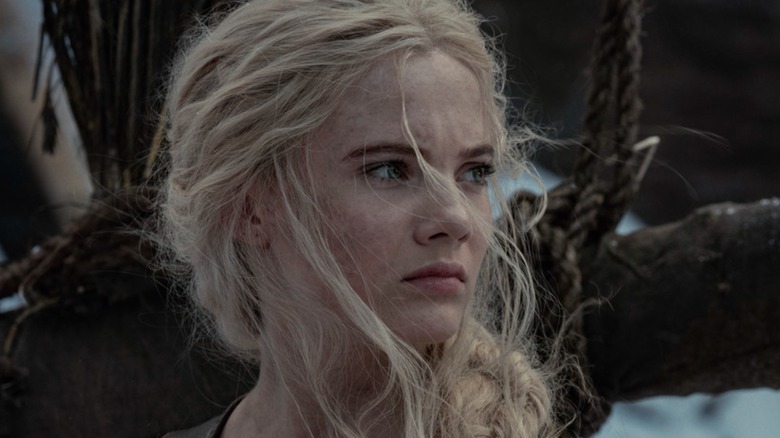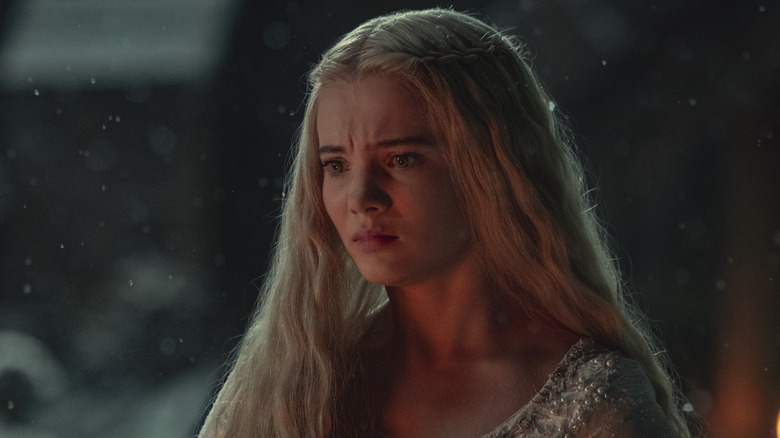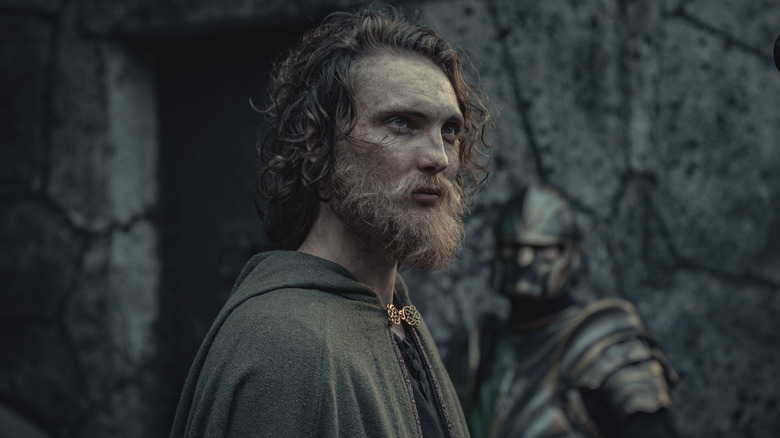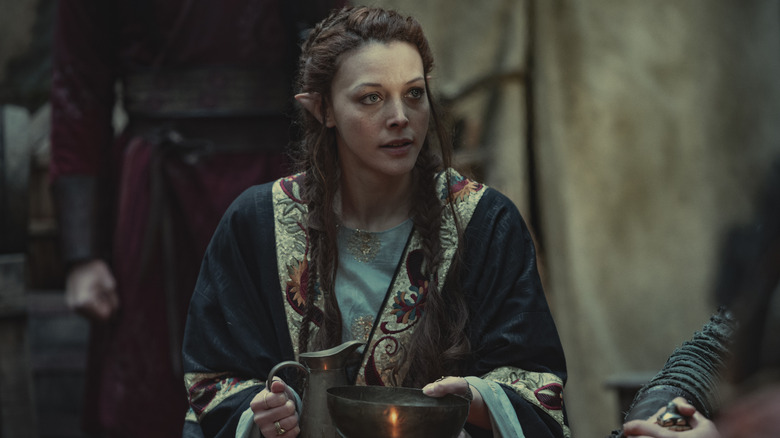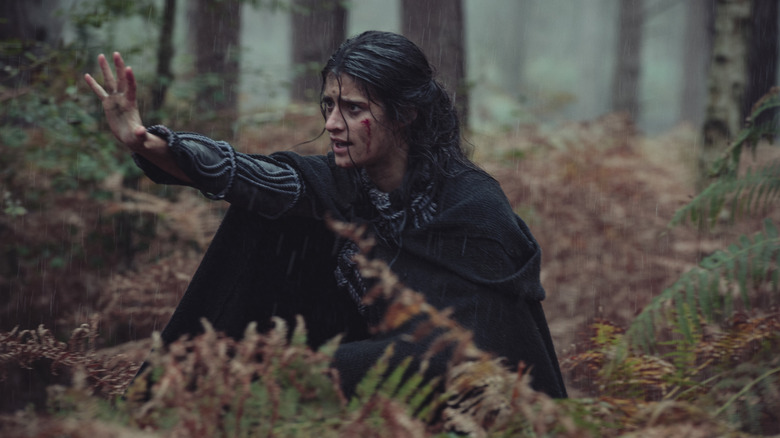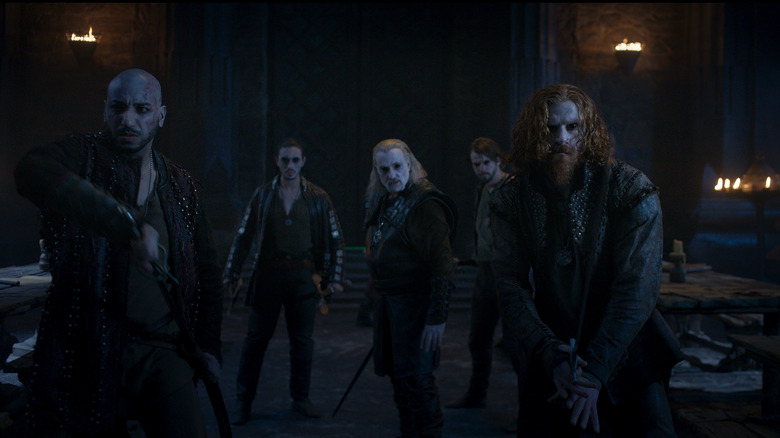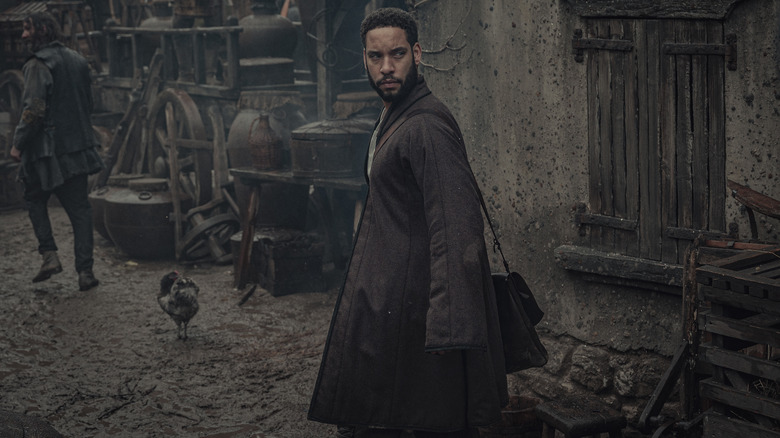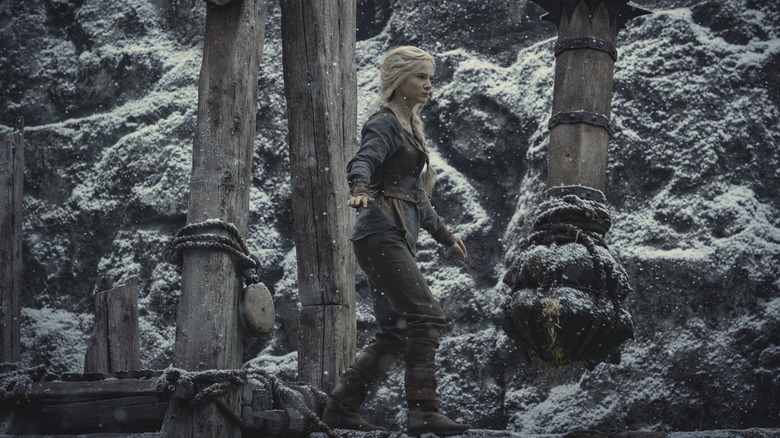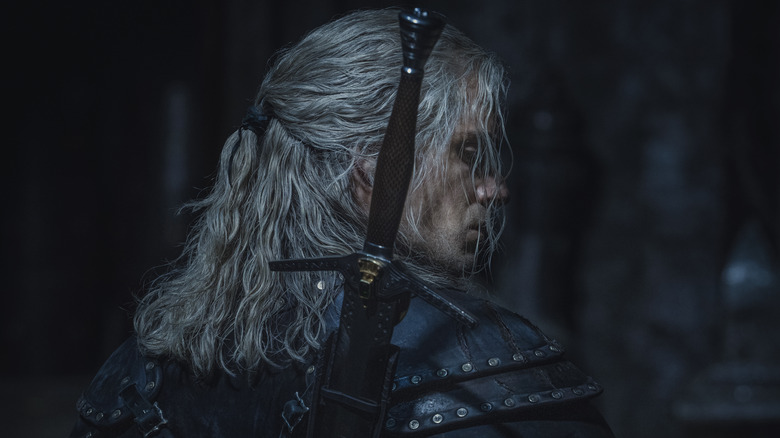The Ending Of The Witcher Season 2 Explained
The following article contains spoilers for "The Witcher" Season 2.
Over eight episodes, "The Witcher" Season 2 blessedly streamlines the chaotic timeline that turned off some fans in Season 1 and dives headfirst into the core plot of Andrzej Sapkowski's bestselling fantasy books. While Season 1 adapted stories from the "Tales of the Witcher" collections to flesh out key characters, Season 2 roughly chronicles the events of "Blood of Elves" and "Time of Contempt" – the first two books in Sapkowski's series.
As such, the second season follows the relationship between Geralt of Rivia (Henry Cavill) and Ciri (Freya Allan), a young woman he adopts through the Law of Suprise. Destiny looms heavily over these two, as it becomes clear Ciri has untapped powers that have the ability to bring a chaotic good or evil to the Continent. The second season also delves into the history of the Continent, with more details about how monsters came to inhabit the land and the role the sorcerers played in their creation. There's also a bit more political scheming and elaboration on the complex tensions between humans, elves, sorcerers, witchers, and the peoples of both the north and the south.
The last episode, "Family," wraps up many of the loose threads uncoiled in Season 2 while answering questions about who Ciri is, what her powers are, and what the prophecy tied to her means. The explosive finale also finally introduces Nilfgaard's White Flame, Emperor Emhyr var Emreis – whose true identity not even a witcher or a mage could see coming. Here's the ending of "The Witcher" Season 2 explained.
The Daughter of Chaos
The second season of "The Witcher" isn't as much about its titular anti-hero, but rather about Cirilla, the Princess of Cintra, or Ciri, as she is more often called. Much of the second season focuses on Ciri trying to learn more about herself and her lineage while different factions hunt for her. This includes groups such as the mages, the elves, and the Nilfgaardians. However, individuals such as the Voleth Meir (the Deathless Mother), a mysterious fire mage named Reince, and Yennefer are also seeking Ciri.
It's revealed in this season that Ciri is distantly related to the ancient race of elves. In the final episode, "Family," the mage Istredd (Royce Pierreson) finds Francesca's group of elves in the woods outside Cintra and tells them Ciri is "Hen Ikeir" (Elder Blood). This Elder Blood offers some explanation as to why Ciri has such incredible untapped powers. It also leads Francesca to believe that Ciri could be the one prophesized by the elven oracle Ithlinne.
We heard bits of Ithlinne's prophecy during Season 1 when Ciri falls into a trance while fighting people trying to capture her. In Season 2, we see Ciri read the entirety of Ithlinne's prophecy from a book at the Temple of Melitele. Before that, Triss (Anna Shaffer) helps her undergo deep guided meditation, in which they learn that Ciri is descended from Lara Dorren, which makes her Daughter of Chaos. All of the female descendants of Lara have been imbued with magical abilities, as she was a powerful elven sorceress.
The White Flame
In a game-changing twist, the mysterious Emperor Emhyr (Bart Edwards) of Nilfgaard, dubbed the White Flame, is revealed to be Ciri's father. The last time we saw her father, previously called Duny, he had been saved by Geralt from death at the hands of Ciri's mother Pavetta's family, including Queen Calanthe of Cintra. This story, called "A Question of Price" in the book "The Last Wish," explains how Geralt came to be the adoptive father of Ciri through the Law of Surprise. After Ciri was born, Duny and Pavetta supposedly drowned in a storm, and their daughter was raised by her grandmother Calanthe.
In Season 2, Duny, aka Emperor Emhyr, is very much alive, although the episode ends on a cliffhanger and offers no other details as to what the White Flame has been up to the past couple of decades. However, his arrival explains why Nilfgaard sacked Cintra and has been on a bloody mission to find Ciri. It also sheds light on why Nilfgaard's leaders knew about her genealogical history and powers even before she did.
Emhyr has a long, bloody history in the books, so expect the ruthless Nilfgaardian ruler to become the main antagonist in future seasons of "The Witcher."
The blood of elves
Season 2 of "The Witcher" finally delves more into the history of the Continent and its people, particularly the elves, who inhabited the lands long before the humans came during the Conjunction of the Spheres.
Though they have a long history filled with magic and prophecies steeped in belief and hope, the elves are the underdogs of "The Witcher." When humans came to the Continent, the entire race of elves was nearly wiped out, as humans considered them lesser beings. Throughout the second season, Francesca Findabair (Mecia Simson) explains bits and pieces of the elves' history and their motivations in working with the humans of Nilfgaard. At the end of the day, Francesca and her people want justice, not revenge.
As both Yennefer and Ciri are descended from elves and imbued with magical abilities, it won't be a surprise if future seasons of "The Witcher" draw deeper connections between elves and the ability to wield the magic of chaos. While some might consider Francesca and the elves a red herring this season, it's clear the blood of the elves and Ciri are more deeply intertwined than first meets the eye.
What's lost is is not always lost
At the end of Season 1, Yennefer uses fire magic to turn the tide against Nilfgaard's forces at the Battle of Sodden Hill and save the day. However, this forbidden magical method comes with a price – Yennefer loses her ability to wield chaos.
Throughout Season 2 of "The Witcher," Yennefer desperately tries to find a cure for her missing magic. During her journey across the Continent, she joins up with Fringilla and Francesca. Together, the three mages eventually encounter the home of Voleth Meir (the Deathless Mother), who has been trapped in her roving hut for centuries. Voleth Meir makes dangerous pacts with the three women to do her bidding, feeding on their pain and fear.
While Fringilla and Francesca make a desperate bid to ensure their own power and safety, Yennefer refuses to let Voleth Meir take Ciri. In the final episode, the magicless Yennefer saves Ciri by becoming the next vessel for Voleth Meir. Ciri then teleports all herself, Yennefer, and Geralt to another sphere of the universe, letting Voleth Meir free, and brings them all back to Kaer Morhen. When they return, Yennefer discovers her magic has returned.
The moment is a turning point for Yennefer, as much of the first two seasons see her looking out for only herself and being driven by her own motivations. However, beneath those selfish seeming actions is her deep desire to be part of a family. In "The Witcher" Season 2, she finally finds one with Ciri and Geralt.
The Deathless Mother
Voleth Meir, the Deathless Mother, was actually a bit of a red herring in "The Witcher" Season 2. While the appearance of the Deathless Mother and her straw hut on chicken legs connects with the Crones of "The Witcher 3: Wild Hunt" and the mythic tale of Baba Yaga, in the second season of "The Witcher," Voleth Meir becomes a means to an end. Ultimately, the last episode reveals that she was just using Francesca, Fringilla, Yennefer, and Ciri to get back to her real home in another sphere of the universe.
Ciri, in particular, is a powerful tool for Voleth Meir in the final episode of Season 2, as the Deathless Mother possesses the princess's body to wreak havoc on Kaer Morhen. Through Ciri, Voleth Meir kills three sleeping witchers and destroys the sacred medallion tree, revealing a black obsidian monolith encased inside. Voleth Meir then uses Ciri's primal scream to shatter the monolith and open a portal to another sphere, unleashing mutated monsters on the witchers.
The battle is brutal and bloody, as massive mutated basilisks swarm the witchers, killing several before order is finally restored. One scene shows Geralt channeling his inner Harry Potter by slaying a basilisk by shoving his sword through the creature's mouth. In the end, Voleth Meir is back where she belongs after a season of corrupting the pain, fear, and magic of some of the key players of "The Witcher."
Monsters and monoliths
In this season, mage and former lover of Yennefer, Istredd, is a traveling historian studying the Continent's monoliths. He's also secretly acting under the guidance of Stregobor (Lars Mikkelsen), the manipulative mage and member of the Brotherhood introduced in Season 1.
Through Istredd's travels, we discover more about the history of the Continent, its monsters, and what the monoliths have to do with it all. It's Istredd and Geralt who travel to the massive crack in the earth caused by Ciri's scream to try to find out where all these new monsters are coming from. With them, we learn that the monoliths are gateways to the other spheres of the universe and that those spheres contain all sorts of dangerous creatures. Finally, through Istredd, Geralt learns Ciri has the power to topple these monoliths, which can open portals to the other spheres.
Towards the end of the season, Istredd visits the famous Codringher and Fenn, a detective agency and law firm, to try to learn what "a witcher, a monolith and mysterious girl have to do with Nilfgaard." He learns about Ciri's Elder Blood and her connection to the elven sorceress Lara Dorren. In their research, the detectives decipher that when the elves fought the humans centuries before, they didn't just build a weapon to destroy their enemy — they built a warrior. These revelations may offer hints as to why Francesca and the elves are so keen to get to Ciri.
The Wild Hunt
In the Season 2 finale, Ciri, Geralt, and Yennefer portal to another sphere and encounter the riders of the Wild Hunt. These undead warriors tell Ciri to join them, explaining to her that she belongs with them and even calling her the "starry-eyed daughter of chaos."
In the live-action series, not much is said about the Wild Hunt in Season 1 and 2 beyond some brief mentions, which makes it interesting that they finally show up in the last episode. Beyond that, their appearance also adds another faction who is after the prophesized Child of Surprise. In "The Witcher," the riders of the Wild Hunt are essentially a version of the Four Horsemen of the Apocalypse – a portent of doom and destruction. The people of the Continent believe the WIld Hunt are undead beings who signal the arrival of war and death.
The Wild Hunt — who are actually Aen Elle elves — are also known as the Wraiths of Mörhogg, a group that invades other spheres to wreak havoc and capture slaves. Since their motivations are death and destruction through invasion, the arrival of the Wild Hunt sets up another key antagonist in future seasons of "The Witcher." Should they manage to get Ciri's powers and bloodline in their hands, the Wild Hunt could truly become a force to be reckoned with.
Blood Origin
Don't skip the end credits of "The Witcher" Season 2, or you'll miss the first teaser trailer for "The Witcher: Blood Origin."
The prequel series is set over 1,000 years before "The Witcher" and follows the events leading to the Conjunction of the Spheres, which merges the worlds of humans, elves, and monsters into one. The series is also set to explore the creation of the first witcher. This teaser focuses on elves played by Michelle Yeoh, Laurence O'Fuarain, and Sophia Brown, who band together to journey across the Continent, training with one another and also shows an early conflict with some heavily-armed men.
No more details have been released for the prequel series beyond its 2022 arrival date, although the teaser's footage also shows brief shots of what looks like the elves' world before humans arrived. This includes a shot of a mage holding the staff that makes up the series' logo and another elven sorceress in full regalia and makeup.
"The Witcher" Season 2, especially the ending, adds tons of details about the history of the Continent and its people. However, fans can surely expect "The Witcher: Blood Origin" to delve even deeper into the history of this fantasy world.
